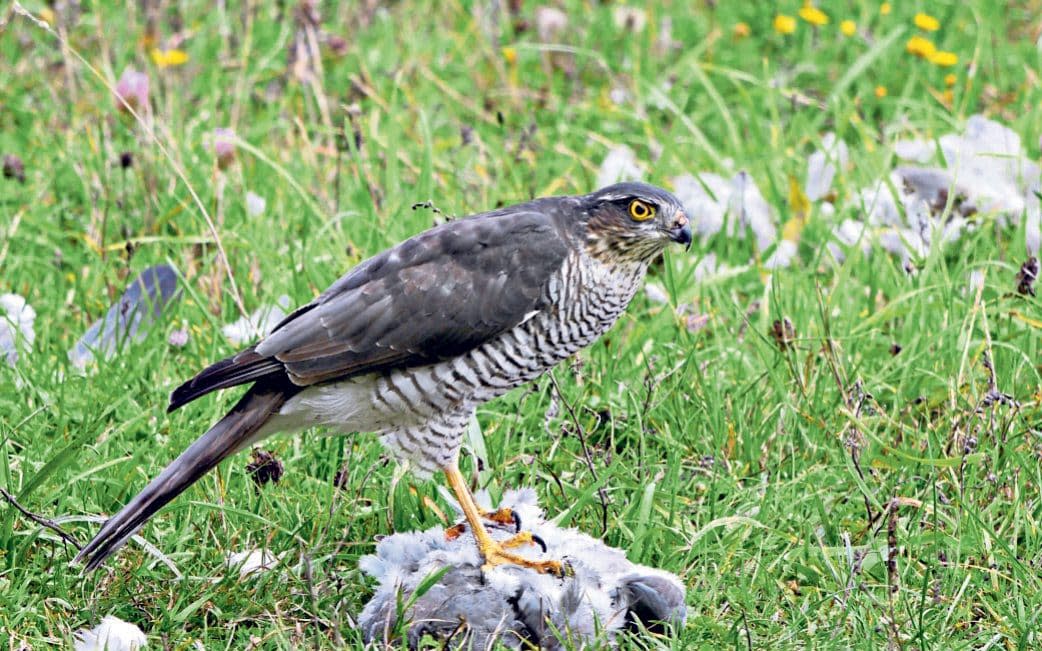If you take a moment to stare absent-mindedly into the garden, you never know what you might spot

My late grandad always ate his breakfast standing up, usually half-dressed for work, with his shirt untucked and no tie or – after he retired – his striped flannel pyjamas. As a child I remember watching him from the kitchen table as he stared out of the window into the garden. I never understood why he didn’t join us – what was so interesting out there? How could he eat so comfortably without a chair?
As I grew I learned, of course, that the garden made the perfect breakfast view. I can well imagine his 10 minutes through the window were the perfect way to start each day, and often wonder what he saw over the years.
Like Grandad, I love staring into the garden, often, like him, with breakfast and no chair. Usually there’s not much to see, unless a flock of sparrows has descended on the feeders or a lone robin pops in. If I’m lucky I’ll catch the blackbird at the rowan berries or the mouse stealing biscuits from the hedgehog feeding station.
But mostly it’s quiet. I look at the reflections in the pond water, the climbers that are slowly colonising the trellis, the shrubs I’ve yet to move.
Last week, during another miserable rainy morning, I breakfasted at the French doors opening out to the garden. I watched the rain hit the pond, the rain hit yellowing leaves, the rain bounce off swaying bird feeders.
There were no sparrows or starlings to laugh at, and the sky overhead (which I always scan, just in case I see something fancy) was empty. Heavy cloud ensured there were no reflections in the pond, and the climbers looked quite bedraggled after what seemed like 20 days of storms. I finished my muesli and started to turn away, when something caught my eye: a sparrowhawk.
The sparrowhawk is a small bird of prey, which evolved to hunt in woodland and is therefore suited to gardens. Males are the size of a blackbird, blue-grey with orange-brown bars on the belly, and females are larger, brown and with brown bars. They hunt anything from small birds to starlings and pigeons, and their presence is a sign of a healthy garden bird population.
This one has been coming into my garden since before I moved in. Neighbours text me photos of it resting on my shed roof, or descriptions of gruesome kills two or three doors down. But until last week I hadn’t seen it with my own eyes.
Amazed that she and I had breakfasted together for 10 minutes without either of us realising, I quietly reached for my binoculars for a better look at her. A female, her large brown body was soaked though. She’d found the perfect spot, perched at the pond edge beneath the small willow tree, which protected her from rain.
She picked at something feathery and bloody. A pigeon, I wondered? Or a starling? I watched her tear strips of meat and eat them, before she picked up the carcass with her talons and flew off with it.
I rushed to the scene. She’d eaten the lot, wings and all, leaving only a bloody beak behind (Twitter helped me identify this as a goldfinch). How lucky I was to have been breakfasting at the French doors, at just the right time.
I learned a lot from this brief encounter. It struck me how much I revelled in the pond-side gore and accepted the loss of the goldfinch. If she’d been a cat or magpie I would have been much less impressed. What does that say about me?
I also learned that it’s always worth staring into the garden. I think back to the things I’ve seen by just looking absent-mindedly – daydreaming if you will – often when I should have been doing something else. The first swift of the year, buzzards over the high street, a frog shovelling a worm into its mouth. And now this, a sparrowhawk eating a goldfinch. I wonder what Grandad would have made of that.


